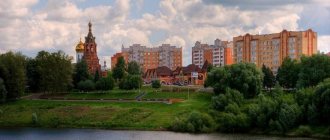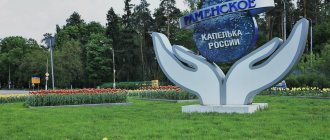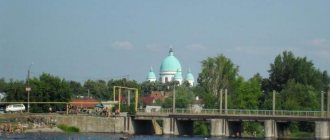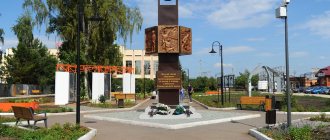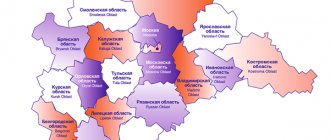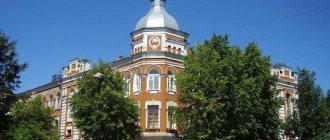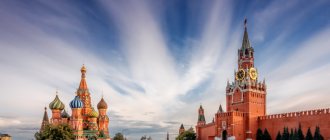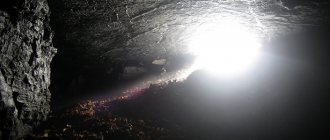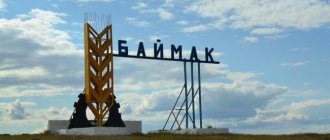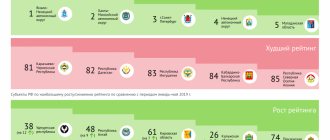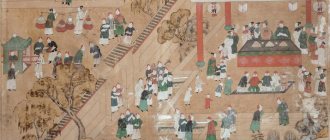The city of Ramenskoye is located in the second zone of cities near Moscow. This is precisely what its disadvantages and advantages are associated with. Good infrastructure, low level of environmental pollution, comfortable urban space and... quite a long road to Moscow.
The city of Ramenskoye is the administrative center of the district of the same name in the southeast of Moscow. It is located at a sufficient distance from the Moscow Ring Road (30 km along the Ryazanskoye or Yegoryevskoye highway). According to 2015 data, the city's population is more than 106 thousand people.
Ramenskoye city on the map
The nearest cities are Zhukovsky, Bronnitsy and Elektrougli.
Is Ramenskoye really one of the most environmentally friendly cities in the Moscow region?
Located at a decent distance from the Moscow Ring Road from the north and east, the city of Ramenskoye is surrounded by pine forests, in some places there are birch groves, and in the southwest the Moscow River stretches along the city. Flowing from the capital, it can no longer boast of cleanliness, but fortunately, there are other bodies of water in the surrounding area.
Central city park near the registry office
It’s noticeably easier to breathe in Ramenskoye, the air is clean not only thanks to the forests, but also due to the low number of anthropogenic pollutants. It’s no wonder that there are many sanatoriums in the area for people with lung diseases. One of the nearest rest houses “Lesnoy Gorodok” is located on the banks of the Doninka River.
So the second pleasant feature of the city is the absence of heavy hazardous industries. Although there was once a textile factory in its center a hundred years ago, now there are only a dozen small enterprises here. On its territory there are mechanical and instrument-making factories that produce bread, and nearby there are meat and dairy factories.
The work of the Vim Bill Dan Drinks plant in Ramenskoye has long been stopped. The small number of industrial zones is occupied by car services and final production of building materials, furniture, etc. Such enterprises do not have a significant impact on the environmental situation.
View from the city park to the lake. Borisoglebskoye and a small industrial zone in the distance
More significant pollution of surface waters occurs, but even here the situation cannot be called critical. Also, according to research in 2005, there are about 10 unauthorized hazardous landfills in the vicinity of Ramenskoye, but in terms of their scale they are noticeably inferior to the zones in Zhukovsky and in the area of the village. Gzhel and Glebovo. However, it is noticeable that in the city of Ramenskoye they strive to maintain order - it is quite clean both in the courtyards and in the parks.
Geography of Ramensky district
Ramensky municipal district is located in the south-eastern part of the Central Moscow region, more than 40 km from the Russian capital. The area of its territory is 1401.12 square meters. km.
This is one of the oldest administrative-territorial entities in the region. In 2014 he turned 85 years old.
The district has common borders with nine other Moscow region regions: Balashikha, Lyuberetsky, Pavlovo-Posad, Noginsky, Voskresensky, Orekhovo-Zuevsky, Stupinsky, Vidnovsky and Domodedovo.
There are three airports in the region: Myachkovo, Bykovo and Ramenskoye; several highways were put into operation, including the M5 Ural federal highway; two lines of the Moscow railway were laid.
According to its geographical location, the region belongs to the Moscow time zone.
Local authorities
The local government system includes:
- Head of the region;
- Ramensky Council of Deputies;
- District administration and its territorial divisions.
The formation of the deputy corps is carried out every 4 years by universal secret ballot. Based on the same electoral right, the Head of the region is elected. Since 1996, the Ramensky district has been headed by Vladimir Fedorovich Demin.
Subordinate to the local administration are 21 municipalities, including the regional center - the city of Ramenskoye, 15 rural and 5 urban settlements: Bykovo, Udelnaya, Kratovo, Ilyinsky and Rodniki. In total, there are about 240 settlements in the region. The cities of Zhukovsky and Bronnitsy, located in this area, belong to the category of settlements of regional subordination.
Population
Ramensky district is one of the most densely populated regions of the Moscow region. According to 2014 data, over 270,000 people live here. Slightly less than half of them are residents of the regional center - the city of Ramenskoye. In 2012, it was recognized as the most comfortable urban settlement in the region.
Climatic and natural features
The climate of the area can be described as moderate continental. The average annual air temperature here ranges from - 7 to + 18 degrees. The amount of precipitation does not exceed 450 - 550 mm. The rainiest month is July.
The nature of the region is represented by two landscape provinces, the border between which is the floodplain of the Moscow River. The left bank (eastern) part of the region is located on the territory of the swampy Meshcherskaya lowland. In the west of the Ramensky Territory, the hilly terrain of the Moskvoretsko-Oka Plain predominates. A characteristic feature of this territory are numerous ravines and deep river valleys.
The highest point in the area is considered to be the Borovskaya Kurgan, located near the village of Chulkovo. The height of its slope is 65 meters. Today, two modern ski centers are based here.
A dense network of small rivers flowing through the region feeds the main water artery of the region - the Moscow River. At its confluence with its tributaries there are a large number of lakes, the largest of which - Borisoglebskoye - is located in the very center of Ramenskoye.
Minerals
In the region, white limestone has been mined for several centuries, the mineral from which the white-stone Kremlin chambers were built. The presence of rich deposits of special white clay gave impetus to the development of the famous Gzhel porcelain craft; during its more than six-century history, Gzhel experienced different periods. For centuries, Gzhel peasants produced wholesale household items, tiles, and roof tiles. In the 19th century, Gzhel craftsmen invented a new material and a new technology: they produced semi-faience, then faience and, finally, porcelain. Of particular interest were items painted in one color—blue underglaze paint applied with a brush, with graphic detailing. Numerous small factories and large enterprises were engaged in the production of porcelain and earthenware. Here, in close proximity to the settlement of Yeganovo, the second deposit of quartz sand in the region is located.
Folk culture clearly manifests itself in folk crafts. Many crafts have survived to this day, and the products of Russian craftsmen, being a manifestation of folk culture, decorate the interiors of homes both in Russia and abroad. Crafts are primarily functional, but today they are often of a souvenir nature. At the same time, their value remains - after all, they continue the folk tradition.
Flora and fauna of the region
Under the influence of human economic activity, the flora and fauna of the Ramensky region have changed significantly. Many species have disappeared completely, others are on the verge of extinction.
The area of forest plantations has decreased by up to 30%. Today, swampy pine forests predominate in the east of the region, and mixed-grass birch and aspen forests in the west. Indigenous species are represented in separate groups - spruce forests and oak forests. In the area of the Pakhra River, trees whose age is 250 - 300 years have been preserved.
The fauna of the Ramensky region is represented by animal species typical of the Moscow region. These are badgers, stoats, hedgehogs, foxes, raccoon dogs, wild boars, bats, etc. In the south of the region, the steppe polecat and stone marten are found. The creation of hunting reserves led to an increase in the number of hares, squirrels, moose, martens, and deer. In total, several dozen mammals, 11 species of amphibians, a small population of reptiles, and over 170 species of birds have been recorded in the Ramensky district, including thrushes, hazel grouse, bullfinches, woodpeckers, sparrows, magpies, ducks (mallards), scorches and lapwings.
Trifonova Natalya Vladimirovna
Is the water good in Ramenskoye?
Despite the generally favorable ecology of the area, reviews from residents of Ramenskoye about the quality of water are not always positive. They say that bad water, which quickly forms an impressive layer of scale, is found mainly in old houses, while in new buildings the water quality is better. Specifically, they spoke negatively about water in the Kholodovo area and more positively in houses on the street. Guryev and Instrument Makers. In any case, residents cook exclusively with filtered water, and prefer to drink purchased bottled water.
For those who are accustomed to the Moscow water supply, the new qualities of water may not immediately suit them. For example, former Muscovites advise rinsing your hair after washing with filtered boiled water and washing your face with it.
Forest resources of the area
In the Ramensky district there are still islands of huge forests that used to occupy a larger area of the entire Moscow region. The tree species there are very diverse. Coniferous species make up sixty-five percent of the entire forest belt. The Ramensky region is covered mainly by sedge-leaved forest. In those areas where birch and pine grow, herbaceous plants such as cornflower, reed grass, and cat's paw are common. Blackberry bushes and drupes are common. Much less often you can see blue blue, martin and two-leaved lyubka.
Are there environmentally unfavorable zones in Ramenskoye?
From time to time, the topic of radiation pollution comes up in discussions of Ramensky's environmental situation. The fact is that in 1985, near Lake Solnechnoye (now called Hydra) at the intersection of the street. Sosnovy Bor and Desantnaya, an illegal dumping of radioactive waste containing radium-226 was discovered. A small area of 1.2 hectares was named “Ramenskaya anomaly”. At the beginning of the 21st century, the soil in this place was decontaminated. According to reports, the contamination was eliminated, and some residents still independently checked the area with instruments, not noting an increased background radiation.
Today there is no unanimous opinion on how safe the area near Lake Solnechnoye is. The anomaly is believed to be in a stable state and does not pose a threat to the population. A slightly increased background can be detected locally, in pits from which soil and waste were presumably removed. Of course, it is better not to visit this place again, although many residents swim in the lake without fear.
As for living in nearby areas, there is no reason to worry. Radium is an inert gas that can only penetrate the first floor of a building in which technical errors were made in laying the foundation. Thus, you can neutralize the possible negative impact by choosing an apartment on a higher floor.
Special objects in Ramenskoye
How will the opening of the airport in Ramenskoye affect the comfort of residents?
At the junction of the cities of Ramenskoye and Zhukovsky there is a small airport, which until recently was used for air shows and flight tests. In March 2016, it will open as a fourth international terminal and will launch charter and cargo flights, targeting the economy class segment.
To begin with, no more than 5-6 flights are planned per day with a total annual passenger flow of 1.2 million people. But by 2022 it is planned to increase passenger traffic to 10 million people, which is comparable to the current figure for Vnukovo Airport (12 million passengers per year).
However, city residents are not particularly happy about this development prospect. Firstly, the opening of civilian flights will significantly increase the load on all types of transport links with Moscow. Local residents are skeptical about plans to widen the highway for the occasion and introduce express trains to the airport - this would hardly ease the already existing traffic congestion.
Secondly, the close proximity, and from the runway to the center of Ramenskoye is only 5 km, will definitely affect the environmental indicators of the city. This includes increased noise and air pollution, both from the planes themselves and from increased automobile traffic. The situation is aggravated by the fact that Ramensky’s wind rose in relation to the runways is clearly not in favor of the townspeople - the city is characterized by north, west and south-west winds.
The expected 5-6 flights per day at the beginning, of course, will not cause much discomfort, but a tenfold increase in this figure may reduce the attractiveness of living in this city.
By the way, back in 2015, a precedent arose with one of the new buildings due to its proximity to the airport. By a court decision, the construction of the Solnechny residential complex, being built, was suspended. The project, already partially occupied and almost sold, turned out to be unacceptably high-rise for the proximity to the runway just 2 km away. Most likely, the problem will be resolved in one way or another, and shareholders will receive their apartments, albeit with a delay in delivery deadlines. At the same time, the residential complex “Solnechny” has already earned a dark stain on the reputation and fears of residents for unpredictable court decisions.
As for the advantages of proximity to the airport in Ramenskoye, they barely matter. How many air flights per year do most residents of the Moscow region make? Once or twice, maybe three times. It is unlikely that the flight is selected taking into account the accessibility of the airfield. Job creation? But the airport will, first of all, need relatively unskilled workers who already have no problems applying force. Of course, the airport will increase the demand for rental apartments in the city. But this is also interesting to very few.
In fairness, it should be noted that with proper development of the airport project, this will contribute to the active development of infrastructure, and accordingly, investment in the city and an increase in the standard of living in it. But still, city residents hope that the new airport will suffer the same fate as the airport in Bykovo, which operated for only a short time and was then closed.
How long does it take to get to Moscow from Ramenskoye?
Convenient transport links with Moscow is one of the most important characteristics of the satellite city. In the case of Ramenskoye, everything is somewhat ambiguous. The city is in the “second echelon”, behind Lyubertsy and Zhukovsky. Therefore, it takes quite a long time to get there by personal transport. On average, the journey to the Moscow Ring Road along the Ryazanskoye or Yegoryevskoye highway takes 40 minutes.
During morning and evening rush hours, as well as on weekends, traffic jams form at key junctions in Lyubertsy, along Lermontovsky Prospekt and st. Tupolev at the crossing over the railway tracks in Ramenskoye itself. Unfortunately, cases when travel time can reach 1.5 hours are not so rare.
Path to the railway station in the city center
Getting to Moscow from Ramenskoye is easy by public transport. By train to the station. Vykhino metro station is about 40 minutes (1 hour to Kazansky station), about the same time it will take by bus from Vykhino or Kotelnikov. True, the bus can unpredictably get stuck in a traffic jam, but electric trains run at short intervals.
At a distance from the Moscow Ring Road, residents of the city of Ramenskoye see at least one advantage - at their stations during rush hours they can still freely board a train. Within the city there are platforms “42 km”, “Fabrichnaya”, “Ramenskoye”, “47 km” and “Sovkhoz”.
Communication between the cities of the Ramensky district is not very well developed. If you get to Zhukovsky, Lyubertsy, Bronnitsy (bus no. 38), village. Gzhel (bus no. 36, 51) is not a problem, but you can only get to the towns of Elektrougli and Elektrostal by personal transport or through Moscow.
One of the city garage complexes
In the old areas of the city, the parking situation is gradually deteriorating, which the administration, in attempts to organize, is only reducing the spaces available for cars. In new buildings in Ramenskoye, developers are still better able to solve this problem at the design stage.
Water resources of the area
Twenty-six rivers and many streams flow in Ramenskoye. The most extensive is Pakhra in the north-west, the fast Pekhorka is in the north, and Severka is in the south of the region. In this area they all have a fairly quiet current. Shrubs and small trees cover their coastal area. Incredible landscapes near Velinka, Severka, Gzhelka. In the Ramenskoye region there are two reservoirs and many ponds. There are also twenty-one lakes there. General, Dachnoye and Igumnoye are recognized as the most abundant, and Borisoglebskoye, located in the center of Ramenskoye, is the deepest reservoir. All rivers in the region are tributaries of the river. Moscow.
How well developed is the infrastructure in Ramenskoye?
The self-sufficiency of the city is always a big plus when choosing where to buy an apartment in the Moscow region. Almost the entire range of products and services is presented in Ramenskoye, albeit in a much smaller range, in accordance with the scale of the city.
As Andrey Krotkov, General Director of the Zeppelin Management Company, spoke about the state of commercial infrastructure: “The infrastructure in Ramenskoye is quite well developed... Thus, shopping centers are represented by more than a dozen objects, not counting those under construction. These include large stores, malls, medium-sized shopping centers, and small shops.
Retail buildings in Ramenskoye are aimed both at residents of the city and nearby settlements, and at the potential of new buildings. I would like to note that Ramensky is characterized not only by the sufficiency of retail space and its diversity, but also by its civility.
Firstly, there is a high saturation among tenants of chain and Russian brands (Perekrestok, Eldorado, ArborMundi, Beringov, Your Zoloto, Yashma-Zoloto, StarGalaxy, etc.). And also the competence of property owners in Ramenskoye is indirectly confirmed by the fact that they are increasingly turning to professional management companies.
For example, under the terms of the tender at the end of 2015, Zeppelin received integrated management of the infrastructure of the Solnechny shopping center with an area of 9,018 square meters. m. on the station square near Ramenskoye station. Our functionality also includes environmental support for the facility.”
One of the central shopping centers of the city of Ramenskoye
The houses have grocery and hardware stores, pharmacies, and hairdressing salons. True, for large-scale shopping it is better to go to the Belaya Dacha Mega, where the largest hypermarkets are concentrated. In Ramenskoye, it is also planned to open a shopping center on the street in 2016. Chugunova, and in neighboring Zhukovsky the Atlas Park shopping center will open with the O'Key hypermarket and other well-known chain stores. A large shopping mall is preparing to open in March 2016 near Zaozerye.
As for specialized stores, you also don’t have to go to Moscow for them. In Ramenskoye you can find goods for hobbies, for mothers and children, almost any construction equipment, household appliances and furniture.
There is also a business center in Ramenskoye
But in the social sphere, according to residents’ reviews, not everything is as wonderful as we would like. You must enroll in kindergartens immediately after the birth of your child. School classrooms are overcrowded. In total, there are 21 schools in Ramenskoye, two of which have the status of a gymnasium.
The worst situation in Ramenskoye is with regard to medicine. There are not enough specialists in both adult and children's institutions, and many residents do not have much confidence in the available doctors, especially when it comes to serious illnesses. There are also paid centers, which, unfortunately, also do not guarantee a high level of qualifications.
By the way, most new buildings build children's educational institutions on the territory as a mandatory infrastructure, but this does not solve the problem of the increasing load on medical institutions.
A kindergarten and fitness center in the courtyard of one of Ramenskoye’s modern new buildings
You can also note the beautiful registry office with a main hall and a fountain at the main entrance. Religious buildings include several churches located on the outskirts, and the Cathedral of the Life-Giving Trinity on the shores of Lake Borisoglebsk in the city center. Within the city of Ramenskoye there are also two small cemeteries, and there is another one on the outskirts, away from the settlements.
Trinity Cathedral in Ramenskoye
Ramenskoye
According to historians, the name “Ramenskoye” (“Ramenki”, “Ramenye”) comes from the word “ramen”, which the ancient Slavs used to call the edge of the forest, where the land could be used for arable land. The history of the city of Ramenskoye dates back to the beginning of the 14th century. The first mention of the grand ducal estate of Ramenye near Moscow is found in the spiritual charter of Prince Ivan Kalita in 1328, where Ramenye is named among the prince’s possessions. Ivan Kalita bequeathed this volost to his wife, from whom it passed to their grandson, Prince Dmitry Ivanovich Donskoy.
In the 14th century, the Ramenje volost covered a significant territory along the left bank of the Moscow River, on which there were numerous settlements. The nature of the area was varied, most of it was occupied by vast forests. Presumably, one of the main occupations of the local residents was beekeeping - collecting honey from wild bees. Part of the income from the craft went to the princely treasury, from which tribute was paid to the Horde. Apparently, beekeeping did not bring much income; the amount of tribute was 5 rubles and occupied one of the last places in the tribute lists.
In 1389, Prince Dmitry Donskoy bequeathed “Rameneytse with bee-keepers and what attracted him” to his youngest son Ivan. Ivan Dmitrievich was incompetent and needed care; he was, as they said then, “not of this world.” After his death in 1393, the volost came into the possession of the eldest son of Dmitry Donskoy, Grand Duke of Moscow Vasily Dmitrievich, who bequeathed it to his son Prince Vasily Vasilyevich (Dark).
Vasily II Vasilyevich the Dark, before his death in 1462, transferred the volost to his youngest son Andrei (Andrei Vasilyevich Menshoy, Prince of Vologda). After his death in 1485, the volost passed to his elder brother Ivan III, Grand Duke of Moscow. The next owner of the volost was the youngest son of Ivan III, Andrei Ivanovich, appanage prince Staritsky.
Thus, the Rameneitse volost is inherited by the Moscow princes. Before his death in 1537, Andrei Ivanovich transferred the volost to his son Vladimir Andreevich, appanage prince Staritsky, later Dmitrovsky, cousin of Ivan the Terrible. There is a record dating back to 1555, indicating that the “palace village of Rozhdestvenno with villages” was listed behind the Rameneitse volost of Prince Vladimir Staritsky outside Moscow. It is known that during this period there were royal service people in the territory of the volost. The wasteland “Bypass Smolinskaya Backwater” was listed as Alexey Danilovich Basmanov, a boyar who was part of the circle of those especially close to the tsar, one of the initiators of the oprichnina. The Gora wasteland on both sides of Lake Borisoglebsk was in the possession of Trofim Okorokov.
Today Borisoglebskoye Lake is located in the center of the city of Ramenskoye. The name of the lake comes from the names of princes Boris and Gleb, killed on the orders of their elder brother Svyatopolk - the first Russian saints canonized by the Orthodox Church in the 11th century. The name of the lake, which was used back in the middle of the 16th century, indicates that there should have been a church in this place in the name of Saints Boris and Gleb.
In 1562, Ivan XIV the Terrible issued a decree limiting the patrimonial rights of princes, and in 1565 announced the introduction of oprichnina in the state. Considering his brother Vladimir Staritsky to be his main rival and contender for the royal throne, in 1566 Ivan the Terrible took away the Rameneitse volost from him in favor of the palace volost. Later, Prince Vladimir Andreevich was accused of trying to poison the Tsar and was executed in October 1569.
In the first royal will of 1572 it was written: “I give to my son Ivan the volost of Rameneitsev, the volost of Guslitsy, the volost of Selna, the volost of Gzhel.” But in 1581, Ivan the Terrible, in a fit of anger, killed his son. After this, he ordered the construction of the Monastery of the Nativity of John the Baptist in the village of Rozhdestvenno. The lands that previously belonged to Alexei Basmanov and Trofim Okorokov were given over to the monastery. Former guardsmen became monks in the new monastery. Half of the volost, including part of the modern territory of the city of Ramenskoye, ended up in the monastery's possession.
In 1598, a period began that in Russian history is called the Time of Troubles. From 1598 to 1613 the monastery was completely destroyed. In the writing book of the Order of the Great Court for 1631-1633. It is written: “Beyond Lake Zdegosh, on the monastery land there stood the Church of the Nativity of John the Baptist, the Church of the Great Martyr Paraskeva, called Friday, and the chapel of St. Nicholas the Wonderworker; over time, the monastery became deserted from ruin.” The village of Novoe Rozhdestveno was founded on the site of the monastery. In 1619, Patriarch Filaret, the father of the first Russian Tsar from the Romanov dynasty, Mikhail Fedorovich, elected to the throne in 1613 by the Zemsky Sobor, was released from Polish captivity. The village of Novoe Rozhdestvenno, together with the surrounding lands, was transferred to the patriarch and remained in the palace department even after his death in 1633. From that moment on, the volost took the name Ramennitsa, and the village was no longer part of the volost.
According to the census book of 1646, the Ramennitsa volost included 13 villages with a total population of 69 people. At this time, the female population was not taken into account, so we are talking only about the male population. There were 54 peasant and 9 bobyl households in the villages. The largest village was Dergaevo (currently part of the urban settlement of Ramenskoye), with 9 peasant households. The village of Novoye Rozhdestvenno is listed separately; 2 villages are assigned to it, one of which, Klishevo, still exists today with the name Klisheva.
In the middle of the 17th century, on the site of the central part of the modern city of Ramenskoye near Lake Borisoglebsk, there was a graveyard, which was the center of the palace parish. At different periods of Russian history, the term “pogost” had different meanings. In the 15th – 17th centuries, graveyards were usually called small settlements with a church and a cemetery, in which privately owned villages became the centers of community life. There was active trade here - “gostba”. Near the church there were usually clergy courtyards (“parable”). A description of the churchyard on Lake Borisoglebsk has been preserved: “The Church of Boris and Gleb is wooden, stands without singing. In the churchyard there is the courtyard of the widow of the priest Pelageya with her son Fimka, the courtyard of the sexton Karpunka Ivanov, the courtyard of the sexton Fetka Antsyforov, on the church grounds the courtyard of the boby with the children.”
According to information from 1701, there were 78 households on the territory of the palace volost of Ramennitsa. The peasants worked as corvées: they worked mowing the royal meadows, participated in the construction of the sovereign's stable factory in Bronnitsy, transported hay for the factory and various cargoes for the Moscow court. In addition, the peasants paid rent in kind: they handed over from the sovereign land 108 quarters of rye and oats (13.6 tons), 41 heaps and 41 loads of hay, 3 fathoms of firewood (12 cubic meters), 7 rams, 7 cheeses, 265 eggs, 6 pounds nuts
In 1710, the Ramenskaya volost and the village of Novoye Rozhdestvenno were transferred by Peter I into the possession of Count Ivan Alekseevich Musin-Pushkin, who from 1710 to 1711. was the manager of the monastery order. At the expense of his son Count Platon Ivanovich Musin-Pushkin on the shores of Lake Borisoglebsk in 1725-1730. The stone Trinity Church was built, after which the Borisoglebsky churchyard in official documents began to be called Trinity. In 1852, at the expense of the merchant Pavel Semenovich Malyutin, a new Trinity Church was built (Cathedral of the Life-Giving Trinity, also called the Holy Trinity Cathedral), the old church was re-consecrated and received the name Borisoglebskaya. The Church of Boris and Gleb is still located in the center of Ramenskoye and is the oldest building in the city.
In 1740, under Empress Anna Ioannovna, P. I. Musin-Pushkin was arrested in the case of A. P. Volynsky, deprived of all ranks and insignia, count dignity, sentenced to “cut” his language and exiled to the Solovetsky Monastery. In 1742, under the new Empress Elizabeth Petrovna, he was rehabilitated and returned.
In 1747, the estate came into the possession of Count Alexei Petrovich Bestuzhev-Ryumin, a prominent statesman and diplomat. In 1758, Alexey Petrovich “for self-will” was deprived by Tsarina Elizabeth Petrovna of ranks and insignia. He was sentenced to death, but the empress commuted the sentence to exile.
In 1768, the Ramenskoe lands were already registered with Prince Mikhail Nikitovich Volkonsky, the nephew of A.P. Bestuzhev-Ryumin, a favorite of Catherine II, the estate was granted to the prince by the empress “for eternal possession.” During this period, there was a rapid growth of the population, which by the end of the 60s of the 18th century was about 3 thousand people.
In 1788, after the death of Mikhail Nikitovich Volkonsky, the estate passed to his youngest son Pavel Mikhailovich Volkonsky, who became one of the richest people of his time. The prince bought 48 acres of land from the church clergy. Next to the church, he built a two-story hunting house and planted an orchard; on the shore of the lake he laid out a park in which he built a menagerie (today this is the area of the Saturn stadium), in which there were moose, roe deer, wild boars, hares, and squirrels. Ordinary people had access to the park only on holidays. A patrimonial office, a dairy farm, a manor house, a stable, a kennel, a barnyard, a steam mill, a pigsty, and greenhouses were built. The new estates required maintenance; for these purposes, Volkonsky transferred 13 peasant families from his remote estates here. A new village began to form, which was named Novotroitskoye, and later Novotroitskoye-Ramenskoye. The names of the first inhabitants of the village are known: Blokhins-Petrovs, Vavilovs, Gasilins, Baryshkins, Kuznetsovs, Vorotilins, Savelyevs, Potapovs and others.
The territory of the estate, which included the villages of Novotroitskoye, New Rozhdestvenno and numerous villages, amounted to more than 19 thousand acres, most of which was occupied by forests and inconveniences.
P. A. Volkonsky had no children, so after his death in 1808, his sister Anna Mikhailovna, who was married to Field Marshal Prince A. A. Prozorovsky, began to own the estate.
In 1809, their daughter Anna Aleksandrovna Prozorovskaya married Prince Fyodor Sergeevich Golitsyn and later became the next owner of the estate. Golitsyn was a holder of the Order of St. Anne, 1st degree, and headed the Jägermeister office. Fyodor Sergeevich lived in grand style and loved a luxurious social life. The owners rarely visited their estate near Moscow, spending their lives in the capital. Anna Alexandrovna did not share her husband’s hobbies. After the death of Prince F. S. Golitsyn, the family was left with a neglected farm and a debt of 2.5 million rubles. At the direction of the king, a special commission was created to help the family in distress. On the advice of the commission, Anna Alexandrovna built two factories - a paper factory and a weaving factory. The paper mill, located on the Khripani River, brought losses and was closed a few years later.
The wooden building of the weaving factory was built near the village of Novotroitskoye-Ramenskoye on the shore of Lake Borisoglebsk in 1831. Unbearable working conditions caused discontent among the workers, and soon the factory burned down under unclear circumstances. In 1833, two brick buildings of a new factory were built on the same site. In 1842, the Ramenskaya spinning factory was rented by the entrepreneur Khailov, and in 1843 it was leased to the Malyutin brothers (Pavel Semenovich, Mikhail Semenovich and Nikolai Semenovich), among whom Pavel Semenovich Malyutin was the head of all factory affairs.
In 1852, after the death of Anna Alexandrovna Golitsyna (Prozorovskaya), the Ramenskoye estate passed to her son, Lieutenant General, Prince Alexander Fedorovich Golitsyn. At the highest request addressed to Emperor Nicholas I in the same year, he received the right to be called Golitsyn-Prozorovsky, as the grandson of the field marshal general.
In 1852, at the expense of the Malyutin brothers, the Trinity Church was built, which became the largest building in the area. The old church was re-consecrated and given the name Borisoglebskaya.
After the peasant reform of 1861, which abolished serfdom in the Russian Empire, Alexander Fedorovich Golitsyn-Prozorovsky and his wife Maria Alexandrovna divided the estate: 7 villages went to the husband, 6 to the wife. Subsequently, they were unable to organize successful economic activities on the territory of the estate. After the reform, the village of Ramenskoye became the volost center of the newly formed volost.
The Malyutin brothers bought the spinning factory from the Golitsyn-Prozorovskys and expanded it, built new buildings, replaced outdated equipment with modern ones: they installed 4 steam engines, 11 steam boilers, 680 weaving looms, 78,000 spindles. The development of the factory was facilitated by the construction of the railway and the opening of the Ramenskoye station, which led to the emergence of a station village. The Malyutins' weaving factory becomes a city-forming enterprise, around which the village gradually turns into a factory village.
In 1856, the management of the factory was entrusted to the young engineer Fyodor Mikhailovich Dmitriev, who introduced the best practices of the best foreign enterprises and his own ideas, and improved the working conditions of workers. In 1858, a school for the children of workers was opened at the factory, and the working day was reduced to 8 hours. The factory becomes one of the leading Russian manufactories. Under the leadership of F. M. Dmitriev, a school with a library for 420 students, a hospital, a shop with cheap food and goods were opened, and housing for workers was equipped. The development of the factory was facilitated by the opening of the Kazan Railway, the construction of which began in 1862, and the opening of the Ramenskoye station, which led to the emergence of a station village for railway workers. The Malyutins' weaving factory becomes a city-forming enterprise, around which the village gradually turns into a factory village.
In 1876, at the World Industrial Exhibition in Brussels, the Ramenskaya factory of the Malyutins was awarded the highest award - the Great Gold Medal; in 1893, at the exhibition in Chicago, it was also awarded. If in 1843, when the Malyutins rented the factory, the number of workers was 358 people, then in 1871 it reached 1707, in 1900 - 6787 people. According to 1897 data, the population of Ramenskoye was 8,502 people, of which 6,885 were residents of the factory village.
In 1892, on the initiative of former weaver F.I. Polyakov, who was fired in 1891, a political circle was founded at the factory under the leadership of S.V. Korolev. In 1895, Polyakov and Korolev were arrested and, after imprisonment, exiled to Siberia. The Iskra newspaper for December 1901 reported that in the summer, workers at Malyutin’s Ramenskaya manufactory peacefully achieved a gradual reduction in working hours from 11.5 to 9 hours. In March 1905, the Ramenskaya party cell was registered, on whose initiative meetings and rallies are held at the factory.
In 1906, a women's gymnasium opened in Ramenskoye.
In 1907, most of the shares of the Pavel Milyutin and Sons partnership were bought by the large manufacturer Mikhail Nikiforovich Bardygin, who owns weaving, printing and trading enterprises in Yegoryevsk and other cities, the factory became his property.
After the February Revolution, a factory committee was elected by the workers; in April 1917, a subdistrict committee of the party organization was created in Ramenskoye, which included 68 people. After the October Revolution, a district executive committee was created, the first chairman of which was factory worker I. S. Bespalov.
In 1917, the factory was nationalized and renamed the Red Banner Spinning and Weaving Factory.
During the Civil War, the factory, like most enterprises, found itself in a difficult situation. Many workers fought at the fronts, most of the workshops were stopped. In 1922, a gradual restoration of factory activity began, shut down workshops resumed work, 650 workers organized a cooperative housing partnership and began construction of a new village. The laying of the first house in the village was attended by M.I. Kalinin, whose speech took place at a meeting in the hall of the factory school. In 1925, the factory village of Krasny Oktyabr was formed.
The population of Ramenskoye and surrounding villages is growing rapidly. In 1924, the center of Bronnitsy district was moved from Bronnitsy to Ramenskoye. In 1925, the village of Ramenskoye was transformed into a workers' settlement. By 1926, the population reached almost 14 thousand people. On March 15, 1926, the village of Ramenskoye was given city status.
Industrial cooperatives are opened, which in the future will become large enterprises, the electrification of the city begins, agricultural credit partnerships are founded, the largest of which, the Livestock Partnership, had 1,496 members. By 1927, the Red Banner factory reached pre-war production levels.
As a result of the administrative reform of 1923-1929. In May 1929, the Ramensky district was formed, which included more than 100 settlements; the city of Ramenskoye became its administrative center. In the same year, a local history museum was opened in the city, later renamed the Ramensky Historical and Art Museum, as well as the Vorovsky House of Culture.
In the pre-war years, the city had 4 secondary and 2 seven-year schools, a textile factory school, a midwifery school, 2 libraries, a palace of culture with a hall for 1,200 seats at the Krasnoe Znamya factory. New industrial enterprises are emerging: instrument-making, large cooperatives "Transformer" and "Celluloid".
During the Great Patriotic War, the residents of Ramenskoye stood up to defend their Motherland. The city's enterprises worked for defense needs from 1939 to 1944. industrial output increased by 62 percent. On the territory of the city, 5 airborne divisions and a militia detachment were formed. Ramentsy fought in the ranks of the 21st Infantry Division of the Kievsky District of Moscow, in the 5th Frunze Division of Moscow. Residents of the city in the region dug trenches and anti-tank ditches, and the population’s funds were used to build the “Moscow Collective Farmer” tank column and the legendary “Moskvich” armored train, which traveled from Moscow to Leningrad and from Leningrad to Konigsberg. There were 11 hospitals in the city; residents of besieged Leningrad were evacuated here, many of whom remained in the city forever. From the Ramensky district, 24 people were awarded the title of Hero of the Soviet Union, including former factory workers S.I. Solntsev and S.I. Butenin. Several hundred people in the Ramensky district were awarded orders and medals for the defense of Moscow.
In the post-war years the city was restored. New public and residential buildings are being built, the urban economy is developing, big changes are taking place in the spheres of education, healthcare, and industrial cooperation. The Transformer and Celluloid artels become state owned. In the 1950s, the city center was reconstructed, multi-story brick residential buildings were erected on the site of old wooden houses, and the central streets were covered with asphalt.
On December 8, 1954, Ramenskoye became a city of regional subordination. In 1957, by order of the Moscow Regional Council of National Economy, the Krasnoe Znamya spinning and weaving factory was renamed into the Ramensky Spinning and Weaving Mill "Krasnoe Znamya". According to the results of the 1959 census, the city's population was 46.5 thousand people, by 1974 - 69 thousand people.
The products of the city's enterprises are known far beyond its borders. Cranes were used in the construction of the Ostankino television tower in Moscow, the Moscow Circus, the Leningrad TV and other large objects. One of the streets in Ramenskoye is named after him. The Ramensky spinning and weaving mill "Red Banner" successfully worked in the textile market for a long time, in 1993 it was renamed into JSC Rateks, currently all buildings of JSC Rateks are not used for their intended purpose and are rented out.
Experienced Ramensky began his journey with a small cooperative of furriers in the 1920s, in 1935 it was transformed into the Celluloid artel, which produced household products from celluloid, glass and leather. In 1966, the artel was transformed into a calculating instrument plant, which, since 1968, has mastered the production of office equipment, including copying equipment, and since 1977, technological equipment for microelectronics factories. The plant continues to operate successfully today, mastering new types of production.
With modern development in the city of Ramenskoye, historical and architectural monuments have been preserved. New social facilities are being built: schools, kindergartens, clinics, cafes. By 1970, the city occupied an area of 14.4 square meters. km. In 1973, Victory Square was formed next to the lake, reconstructed in 2000. In the same year, a museum of military equipment was opened.
By 1993, the population of Ramenskoye reached 88.5 thousand people. The city continues to grow and develop. Today it is one of the most modern and comfortable cities in the Moscow region.
Culture and features of Ramenskoye
The city of Ramenskoye is really very beautiful. There are a lot of decorations in squares and gardens: small sculptures, flower beds, fountains. The houses are still mostly of old construction - 5 storeys and high panels - standing at a distance from each other. It’s as if you are transported in a time machine to those years when the capital itself was greener and more spacious.
Today in the city of Ramenskoye you can see a picture of the neighborhood of a new building with private plots
Ramenskoye is one of the first cities where the “boxes” of residential buildings turned into bright paintings. Now the facades have faded, but the Internet is still replete with elegant photographs of the city from 5–10 years ago.
Ramenskoye is known in the region for its water stadium "Saturn", where Olympic athletes train, as well as various competitions, as well as the professional badminton club "Favorit-Ramenskoye".
Long-occupied residential complex "Saturn" not far from the sports complex of the same name
The city has fitness clubs, children's development centers, and the Borisoglebsky Sports Palace. Ramenskoye has its own cinema “Yubileiny”, the premieres of which do not lag behind those in the capital. By the way, there are quite a few motorsports fans and related associations here.
Cinema "Yubileiny" in Ramenskoye
Ramenskoye can be called one of the safe and intelligent cities in the Moscow region. This is due to the low percentage of labor migrants and the rather active social position of the residents. In the city’s social network groups, you can quickly consult on any issue, get help, or post an ad.
The city has modern navigation, making it easier to navigate the streets
The warmest, coldest, sunny and snowy month in the city of Ramenskoye
As weather statistics
,
the warmest month in the city of Ramenskoye is July
with an average temperature of +19.1°C.
The second place is August (+18.1°С), the third is June (+17.6°С). Accordingly, the coldest month in the city of Ramenskoye
is January.
The average monthly temperature in January is only −6.8°C. The city of Ramenskoye has the most sun
in June.
Thus, June is the sunniest month in the city of Ramenskoye
.
Let us know if this table is useful to you? Useful table (2406) No (524)
| The warmest | |
| July | +19.1°С |
| August | +18.1°С |
| June | +17.6°С |
| The coldest | |
| January | −6.8°С |
| February | −4.6°С |
| December | −3.8°С |
| More sun | |
| June | 18 days |
| August | 18 days |
| May | 17 days |
| More snow | |
| January | 1 day |
| December | 1 day |
| February | 1 day |
The cost of apartments in Ramenskoye on the secondary market
The secondary housing market in Ramenskoye is quite well developed. The predominant share on the market is occupied by “one-room apartments”; there are slightly fewer “two-room apartments” on the market.
As Irina Kirsanova, Marketing Director of Peresvet-Invest CJSC, commented, the average price per sq.m. according to the Winner database on the secondary housing market of Ramensky - 82,792 rubles. The average price of a one-room apartment is 3.3 million rubles, a two-room apartment is 4.4 million rubles, and a three-room apartment is 5.8 million rubles.
Mostly apartments in panel buildings are offered for sale in the areas of Kholodovo, Aviazhilstroy, 2nd microdistrict, MZhK and Zavodskoye. All these microdistricts are located in the northern part of the city, above the railway tracks.
There are very few offers in “Stalinist” houses, characterized by high ceilings and strong walls. Two- to three-room apartments are sold at prices of 65–85 thousand rubles per sq. m. m. There are even fewer block houses in Ramenskoye, and, accordingly, there are fewer offers on the secondary market.
Apartments in brick buildings in Ramenskoye have a wide range of prices from 62 to 91 thousand rubles per square meter. The reason here is the age of the building itself; there are 4-story brick buildings built in the Soviet Union, and there are modern multi-story buildings with good layouts.
There are quite a lot of brick high-rise buildings in Ramenskoye
Monolithic houses are represented mainly by recently completed buildings in new buildings. Some don’t even have a rough finish, let alone a full renovation. Depending on the availability of repairs, the condition of the house and the distance from the railway station, prices range from 60 to 92 thousand rubles per sq. m. m. And in some monolithic brick houses, for example, in the Kratovo residential complex, the cost per sq. m. meter reaches 97 thousand rubles.
Among the recently built new buildings, apartments in the Zelenaya Okolitsa residential complex, the Severny Park residential complex, and several buildings of the Solnechny residential complex have already entered the secondary market with a certificate of ownership. Registration of ownership of an apartment in the Park on Fabrichnaya residential complex is expected.
Temperature and climate Ramenskoye
Ramenskoye is located in the temperate continental zone. Winter here is not completely frosty, and summer is not very hot. Long-term observations recorded the lowest air temperature - -32.5 degrees, and the highest - +35. This settlement has good moisture. For the entire year, about 450 - 550 millimeters of precipitation falls. The largest of them is in July, and the smallest in February, March, April. About one hundred and seventy-one days a year are not without precipitation. 2/3 of them are rain. In winter, cyclones from the north-west are stable in Ramenskoye, and in summer – from the west and south. Wind speed, on average, does not exceed 3 meters per second.
New buildings in the city of Ramenskoye
According to a review by Irina Kirsanova, Marketing Director of Peresvet-Invest CJSC, there are currently about 16 properties on the market.
Average price sq.m. According to the Winner database, the expert says, on the Ramensky new buildings market - 73,075 rubles. The average price of a one-room apartment is 2.9 million rubles, a two-room apartment is 4 million rubles, and a three-room apartment is 5.4 million rubles.
The main objects of the city of Ramenskoye are large residential complexes, but at a high stage of readiness. Construction is underway both in areas near the railway stations (Ramenskoye and Fabrichnaya) and in remote areas, which have recently been actively improved and developed.”
Thus, in the Ramensky residential complex, 10 buildings have already been completed and another 9 houses are at various stages of construction. Prices sq. meters for February 2016 in the range from 59 to 68 thousand rubles. The developer GC "Garantia Stroy" plans to complete construction at the end of 2022.
The construction of the last building of the North Park residential complex, located on the border with the forest, is being completed. The developer Sinara LLC, in addition to residential buildings, is building a kindergarten for 220 children, surface parking and a shopping center. Cost per sq. meters in a house under construction 54–68 thousand rubles. True, residents are advised not to fall for advertising “forests under their windows,” since most likely these territories will also be built up sooner or later.
Residential complex "Northern Park" has attractive architecture and bright facades of buildings
In the Zelenaya Okolitsa residential complex, the first phase of 4 buildings has already been put into operation. Three more buildings under construction will not disturb the peace of the new residents, and will be commissioned in 2022. The developer “Mosoblinterstroy” plans to open the school in the second half of 2016. Cost per sq. m. meters in houses under construction are 57–61 thousand rubles, while sales in building 3 have not yet begun.
In the courtyard of the Zelenaya Okolitsa residential complex there is a real birch grove
In the last 4 buildings of the Solnechny residential complex you can buy a one-room apartment starting from 2.5 million rubles. Prices per sq. m here from 53 to 73 thousand rubles. Delivery of the second stage is scheduled for the first quarter of 2016, but may be slightly delayed.
According to Irina Kirsanova, microdistrict. 10 - the place is actively being developed, but the microdistrict is located on the outskirts of the city, quite far from the station. Although infrastructure facilities are also being built here: a kindergarten, a school, a shopping center. Price of one-room apartments: 2.4–2.5 million rubles (Winner base). On average, the cost of sq. m in houses under construction 63–66 thousand rubles.
The low-rise residential complex "White Stones" is under active construction. All 4-story buildings are built from brick. This is an interesting option for those who just “escaped” beyond the Moscow Ring Road away from bulky high-rise buildings. True, the design of the facades of this project from the developer RPK-Stroy itself cannot be called outstanding. But the cost per square meter at this stage is from 44 thousand rubles.
In all presented new buildings, 1, 2 and 3-room apartments are sold. There are no multi-room apartments on the primary market at all, but you can buy a studio in Ramenskoye in the Park on Fabrichnaya residential complex. Such apartments measuring 37–38 sq.m. cost 2.8 million rubles. without finishing and 3.5 million rubles with fine finishing and partial furniture. Small, 23 sq.m. studios with fine finishing can be found in the microdistrict. 10, but rather on the assignment of property rights.
If we compare prices for new buildings with neighboring Zhukovsky, then apartments in Ramenskoye are slightly cheaper, which is logically explained by the distance from the Moscow Ring Road, but the buyer receives a bonus in a greener and less populated area.
Map of Ramenskoye with houses
The city center is located near the bus station and the Ramenskoye railway station. The map of Ramenskoye with streets and houses shows that in this area there is an administration building, several shopping centers and a restaurant.
There are almost no low-rise buildings in the city. The city center is built up with high-rise, modern residential buildings. A distinctive feature of the city's architectural and design solutions is the unusual design of the walls of the houses. They are painted in all the colors of the rainbow, decorated with painted butterflies, images of animals and various patterns. Ramensky's map with houses will help you navigate the city while walking; by zooming in on it, you can find any residential building or institution.
The northern part of Ramenskoye is represented by high-rise new buildings, and on the outskirts there are cottage buildings that look modern and do not spoil the appearance of the city.
One of the busy highways, which is always “in full swing,” is Karl Marx Street. On one side it borders Lake Borisoglebsky, and on the other there are all the infrastructure facilities necessary for a modern resident:
- Banks;
- Tax Inspectorate;
- Shops and hypermarkets;
- Clinic;
- Bicycle park;
- MARRIAGE REGISTRY;
- Kindergartens;
- School.
On the map of Ramenskoye with house numbers you can see that one of the most beautiful churches in the city is located here - the Trinity Cathedral. Several more churches are located in other areas of the city.
Walking around the city near Moscow, one cannot help but notice that its streets are very well-groomed; on the detailed map of Ramensky you can find the location of numerous fountains and water fountains. You can often find various sculptures that fit into the general appearance of neighborhoods and become their feature.
conclusions
Ramenskoye is a unique city in the Moscow region, combining good ecology with convenient transport accessibility and infrastructural self-sufficiency. Due to its distance from the Moscow Ring Road, it has not yet had time to turn into another residential area. So far, new multi-storey residential complexes strongly contrast with the private plots in the neighborhood. Here, as in many satellite towns near Moscow, there is a problem with the capacity of social institutions.
Alas, it is impossible to predict whether the situation will improve as Ramenskoye develops or whether the social infrastructure will never be able to catch up with the constantly growing population density.
Ramenskoye has a good selection of new buildings of varying degrees of completion
If you choose where to buy an apartment in Ramenskoye, it is better to focus on the microdistricts north of the railway station, as they are more developed and distant from the new airport. For a potentially prosperous and developing administrative center, new buildings in the city of Ramenskoye are an affordable option, both for living and for investment.
Comfort level in Ramenskoye 12.55 out of 20
| Environmental characteristics | ||
| Green areas | 5 | 4.8 |
| Reservoirs | 5 | |
| Absence of serious sources of anthropogenic pollution | 4 | |
| Visual environment | 5 | |
| Connectivity of the city/region | ||
| Ease of movement within the city/region | 4 | 3.4 |
| Accessibility of Moscow by public transport | 4 | |
| Accessibility of Moscow by personal transport | 4 | |
| Communication with other localities | 3 | |
| Conditions for working within the city | 2 | |
| Social infrastructure | ||
| Kindergartens | 3 | 3.4 |
| Schools | 4 | |
| Children's leisure centers | 4 | |
| Cultural institutions | 3 | |
| Healthcare | 2 | |
| Sports and fitness | 5 | |
| Religious buildings | 3 | |
| Shopping and entertainment infrastructure | 3 | |
| Habitat quality | ||
| State of city utilities | 4 | 3.0 |
| Development of the real estate market | 4 | |
| Parking | 3 | |
| Accessibility for the disabled | 1 | |
| Risks and threats | ||
| Deteriorating transport situation | -2 | -2.9 |
| Underdevelopment of social infrastructure | -3 | |
| Deterioration of the environmental situation | -2 | |
| Oversaturation of the real estate market | -1 | |
